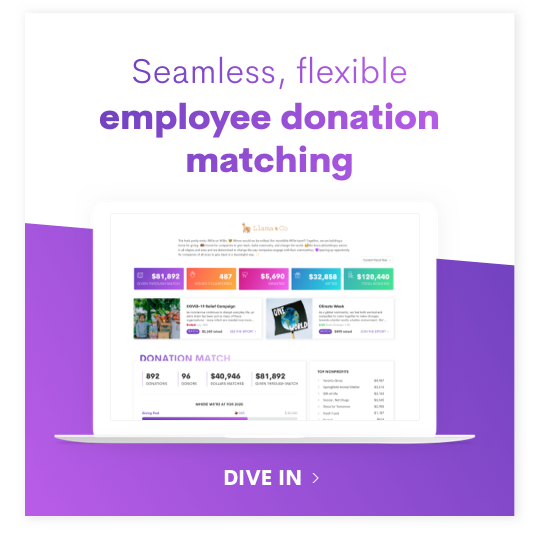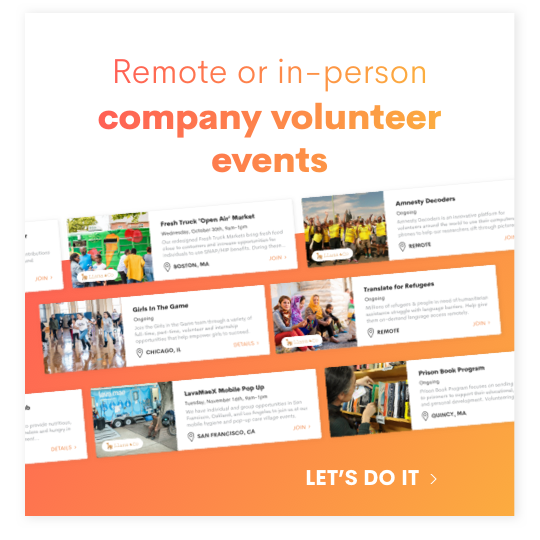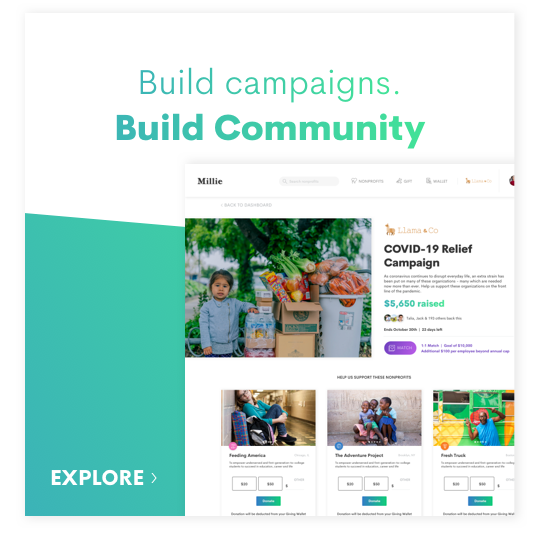Look around and you’ll see a company that matches employee donations. In fact, some estimates say about 65% of Fortune 500 companies offer some sort of matching program. Clearly, there’s something to it. A study by HR Reporter found that employee turnover drops by an average of 57% among employees deeply connected to their company’s giving and volunteering efforts.
So what is it about employee donation matching that offers such clear benefits to companies—not to mention the world at large? And how can you create a matching gift program that will be equally valuable for your employees?
Why Do Companies Not Match Donations?
Let’s start with the opposite question. After all, many people in the position of beginning a company volunteer or donation program often don’t turn the ignition. Why is that? Why does it seem like some companies go out of their way to avoid matching donations? There may be a few reasons here:
- Zero confidence. Let’s say an HR manager or a company social impact coordinator wants to create a new employee matching program. But as they dive into the details, they realize they have some basic points of fear that come up. For one, what if they choose the wrong charity to donate to? That could end up alienating half the company.
- Lack of awareness. Simply put, the will might be there, but people in charge of creating giving programs may not know that there are platforms that can help them along the way. Because of that, they think that corporate matching gift programs are too difficult to establish, or require countless meetings with the accounting department.
- Worries about how to get started. You might read online about a “submission process” to get started with matching donations. Or you might hear about company-wide flubs where companies picked the wrong company. This is what a platform like Millie can help mitigate. It gives you a platform for vetting charitable organizations and setting it up so that your entire company can become eligible donors on your next campaign.
The good news is that donating isn’t, and should not be, that difficult. Setting up giving programs can be much easier if you know the basic steps.
Why Do Companies Match Donations of Employees?
Aside from corporate social responsibility, there are plenty of reasons that companies match donations for their employees.
The first is employee engagement. According to Charities.org, 71% of employees rate a “giving” culture as one of the most important ways to generate genuine camaraderie at work. And 86% of corporate leaders understand that creating giving programs like these is something that employees expect.
Nonprofit organizations and for-profit companies alike understand the power of incentivizing people to give. That’s why corporate giving programs often offer matching donations. But it doesn’t stop there. When you match with a platform like Millie, you can incentivize giving even more, thanks to the following features:
- Charitable dashboards. Need to catch everyone up on the progress of a corporate social responsibility program? By monitoring a donation campaign with Millie, you make it possible for people to view exactly what kind of impact their donations have had. You’ll also show how many matches their donations were able to generate on behalf of the company.
- Unique statistics. Want to find the match amounts each employee is averaging? The matching gift funds your company has made available? With this tracking, your company can also create other incentives. For example, let’s say your company tracks the average donation amount, and if you exceed a certain goal, your company pledges an additional amount of money. Millie makes it easy to view how many donors—across a specific amount of donations—have made contributions through your campaign.
- Centralization. A great company matching program sounds like a plan—until it comes time for employees to actually make their donation. Then, if you don’t have an adequate system for the donations, they can get frustrated. When you use a platform for a matching gift database and everything else that goes into creating this sort of program, don’t forget that you need one centralized web interface so that there’s no confusion.
Contributing corporate matches can also help companies build their public images and improve relations with their audience! Many consumers favor businesses that make an effort to give back and better the world around them, and participating in matching gifts and other corporate philanthropy initiatives is a great way to do it.
What Can You Do with Matched Donations?
The first thing is engagement. Part time employees, for example, might even join up with a matched donation plan when they see the good you’re doing. This is especially true when you have a platform in place that lets you view the progress everyone is making—and the total donation matches you’ve been able to make.
You can also use this chance to create unique gift opportunities. Or you might also frame each donation in the social impact it has with the charity. For instance, when someone donates to Feeding America, they often tell their donors what kind of gift opportunities that donation created. They might say that a donor’s contribution helped feed a certain amount of people. This puts a real face on what the donations are doing, inspiring even more contributions.
But there are a few other options for what you can do with Millie, including:
- Easily integration with social platforms to make sure that your charitable donation campaigns are drawing the interest of employees—not to mention the outside world.
- Create calendars and track goals to ensure that your company ranks as one of the top matching gift companies, if that’s what your organization aims to do. Calendars are also effective because they help everyone—from employees to board members—plan out the year and remain engaged across multiple seasons.
- Build employer matches and employer matching plans that make sense for your budget. Your fundraising strategies ultimately hinge on your budget, after all. You don’t have to make a major commitment on Millie if you don’t want to—you’re free to use the platform to dip your toes in the waters as you build up a long-term match ratio strategy.
- And speaking of match ratio strategy, you can also configure just how much your business wants to match. If you’re unsure, make sure that you consider a match request or two from your company. Hear out their feedback and ask them what sounds fair before you launch the program officially. That way, people will know what their original donation means at the outset of the campaign.
You can be a large company in need of a platform, or a small company looking to announce the first time it matches donations. But you don’t have to be a “Home Depot” or a “General Electric” to have an impact—especially when you approach your new campaign from a strategic point of view.
How Do Matched Donations Work?
The math is pretty simple: when you announce that you’re launching a donation program and that your company is matching donations, you should also announce how much you’ll match. Will you double the donation? Will you match 50%? 100% up to a given amount for the entire program?
If you’re interested in taking a cue from other philanthropically-minded businesses, 91% of companies match donations at a dollar for dollar ratio, with the average matchable thresholds falling between $34 and $3,728. Before you start, you’ll want to settle on these guidelines so you can factor it into the corporate budget.
From there, you should work with a high-quality corporate social responsibility platform so there’s no confusion. Millie, for example, lets you create a matching program within the platform. With Millie, you can create both per-employee caps and total program caps to control how much you’ll be matching. At the same time, the matching program incentivizes employees to jump in and participate.
Fundraising efforts like these require simplification. You’re not going to get a lot out of your fundraising system if employees don’t know how to do the following:
- View the current donations
- Examine the matching options offered by the company
- View which charities they’re giving to
That’s why if you’re looking for “matching gift companies” online, it helps to know that you can incorporate a matching program into the entire corporate social responsibility software. Ideally, this software will let you create entire programs—including scheduling volunteer events and creating online donation forms—to maximize the charitable contributions your employees give.
Once you set the rules and establish the platform for your donation page, you’re then free to get working. You can send out a company email announcing the program, letting employees know that a new corporate philanthropy effort is in place. Let them know that you’re matching employees’ donations! Incentivize them! The match program will immediately get peoples’ attention, drawing their interest in the charity you might have picked through Millie, whether that includes educational institutions or local outreach.
How to Get Started with a Matching Gift Program
It all sounds well and good-but how do you get started with company matches? At Millie, we have nonprofits on our platform and help companies with recommendations to include in their “approved” lists. Ultimately, the decision is left to companies on where they would like to donate, however.
A platform like Millie lets you view all the gift information you’ll need. You can track donation totals, match totals, and even track the kind of social impact your business is having. And you can use the platform to build from the ground up. While large organizations can use Millie, you don’t have to be “Microsoft” to begin a matching gift process for your next social outreach program.
From there, you might also consider how you’re going to budget your new campaign, setting caps on match amounts from the company’s end. From there, let Millie step in and provide total transparency as you update your employees on the status of your campaign.



